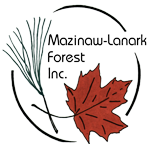Tree marking
Tree marking is a process of selecting trees to be harvested or retained that is conducted prior to actual harvest in order to guide the logging operators and meet the silvicultural objectives of harvest.
- Tree marking on Mazinaw-Lanark Forest is a pivotal operation that allows for integration of the directions from various sources, guides, regulations and prescriptions in microsite level decisions on the ground. Competence in this trade requires years of local experience and up to date knowledge of locally specific standards.
- Tree markers on Crown land in Ontario are licensed under a program developed and administered by the NDMNRF. The principles and standards of tree marking are explained in the Ontario Tree Marking Guide
- With minor exceptions all area harvested on Mazinaw-Lanark Forest is subject to tree marking.
- In addition to tree selection for harvest and/or retention, tree marking involves layout of various management lines such as cut boundaries, Area of Concern boundaries, treatment boundaries, stream flagging etc.
- The standard marking method involves marking trees to cut (using orange paint) where all marked trees are expected to be cut and all unmarked trees (with predefined exceptions) are expected to be retained. Occasionally the opposite method of marking is preferred where trees to retain are marked with blue paint and all unmarked trees (with predefined exceptions) are expected to be cut. Both methods have advantages and challenges, depending on specific forest conditions and objectives.
- Tree markers are required to report and adjust to new values, such as raptor nests, Species At Risk, unmapped streams and others.
